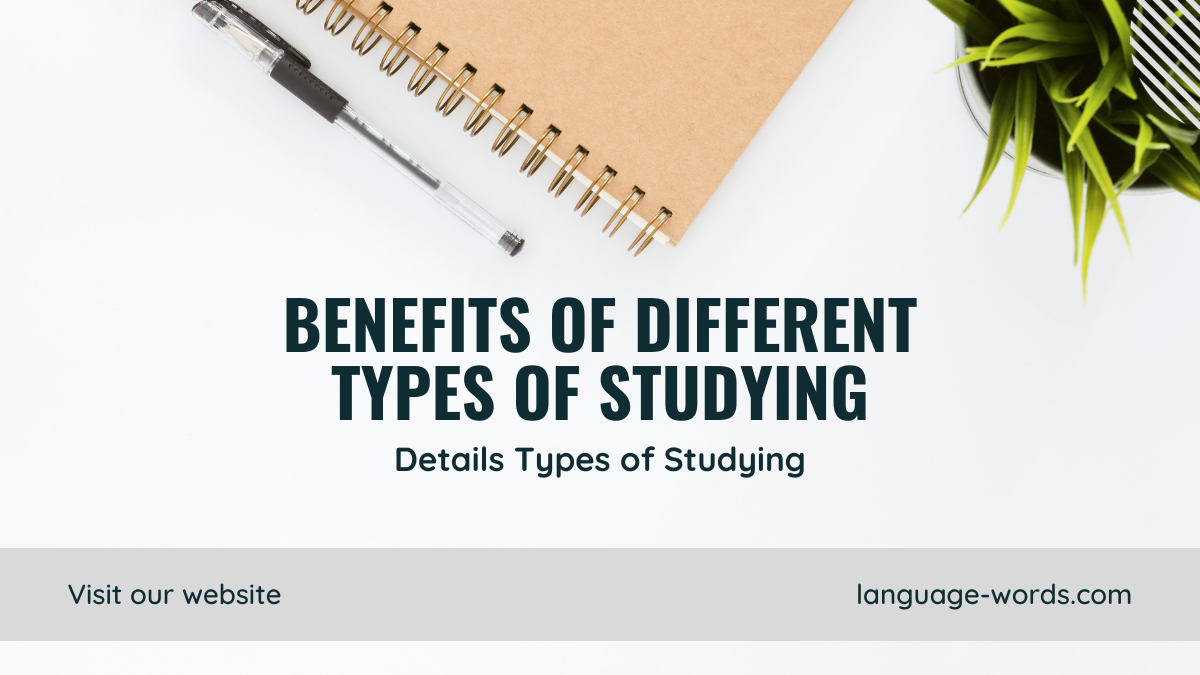When it comes to studying, there’s no one-size-fits-all approach. We all have different learning styles and preferences that work best for us. In this article, I’ll be exploring the various types of studying and how they can enhance your learning experience. Whether you’re a visual learner who thrives on colorful mind maps or a hands-on learner who prefers interactive activities, there’s a study method out there that’s perfect for you. So, let’s dive in and discover the different types of studying that can help you maximize your academic success.
Studying is not just about sitting at a desk with a book and a highlighter. It’s about finding the techniques that resonate with you and make learning a more enjoyable process. In this article, I’ll be sharing some unconventional types of studying that you might not have considered before. From group study sessions that foster collaboration to digital tools that make studying more interactive, there’s a wide range of approaches to explore. So, if you’re looking to shake up your study routine and find new ways to retain information, keep reading to discover the exciting world of alternative study methods.
Types of Studying

Studying is not a one-size-fits-all approach. Everyone has their own unique way of learning and different methods that work best for them. In this section, I’ll explore various types of studying that can enhance the learning experience. Let’s dive in!
1. Solo Studying
Solo studying is a tried and true method that many individuals prefer. It involves focusing on individual study sessions where you can tackle the material at your own pace. This type of studying allows for self-reflection and deep concentration. Some benefits of solo studying include:
- Flexibility: You have the freedom to study whenever and wherever you want.
- Personalized Learning: You can tailor your study sessions to your specific needs and learning style.
- Efficiency: Solo studying allows you to focus solely on the material without any distractions.
2. Group Study
For those who enjoy collaborating and bouncing ideas off others, group studying can be an effective method. It involves studying with a small group of classmates or peers. Here’s why group study can be beneficial:
- Exchange of Ideas: Group study provides an opportunity to discuss concepts, ask questions, and gain different perspectives.
- Enhanced Motivation: Being part of a group can keep you motivated and accountable for your learning.
- Improved Communication Skills: Interacting with others and articulating your thoughts can enhance your communication skills.
3. Interactive Digital Tools
In today’s digital age, technology has revolutionized the way we study. Interactive digital tools offer a dynamic and engaging learning experience. Here are some popular tools:
- Online Quizzes and Practice Tests: These tools can help you assess your understanding and identify areas for improvement.
- Educational Apps: There are countless apps available that cover various subjects and offer interactive lessons and activities.
- Virtual Flashcards: Digital flashcards allow for repetition and reinforcement of key concepts.
Passive Studying

In this section, I will discuss passive studying, which encompasses activities that involve absorbing information without active participation. Passive studying techniques are commonly used to enhance learning, especially when coupled with active learning strategies. Below are three common types of passive studying:
Reading
Reading is a fundamental form of passive studying that allows me to learn and gather information. By reading books, articles, or even online resources, I can gain knowledge on various subjects. It offers an opportunity to understand new concepts, expand my vocabulary, and explore different perspectives. Reading actively engages my brain and stimulates critical thinking skills.
Listening
Listening is another valuable passive studying technique. By listening to educational podcasts, recorded lectures, or audio books, I am able to absorb information without the need for active participation. This technique is particularly helpful for auditory learners who benefit from hearing information. Additionally, listening allows me to multitask, making it suitable for times when I am engaged in other activities, such as commuting or exercising.
Watching
Watching educational videos or documentaries is an effective way to passively study. Visual learning can be highly engaging and memorable. Videos provide a dynamic way to comprehend complex concepts, as they often incorporate visual aids, animations, and real-life examples. Watching educational content not only helps me grasp new information, but also enhances my understanding by connecting concepts visually.
By incorporating passive studying techniques such as reading, listening, and watching into my learning routine, I can maximize my learning potential. It is important to note, however, that passive studying should be complemented with active learning strategies to ensure a well-rounded approach to studying. Engaging in activities like note-taking, problem-solving, and discussions can help consolidate knowledge and promote deeper understanding.
Remember, there is no one-size-fits-all approach to studying. Exploring and experimenting with different techniques will allow me to discover the methods that work best for my unique learning style. So, go ahead and mix And match these passive studying methods with active learning techniques to create a study routine that best suits you.
Stay tuned for the next section, where I will discuss active studying techniques and how they can complement passive studying methods for optimal learning outcomes.
Active Studying
Taking Notes
When it comes to active studying, one technique that has proven to be highly effective is taking notes. Taking notes not only helps you retain information but also enhances your understanding of the subject matter. Here’s why it’s such a valuable strategy:
- Engagement: When you take notes, you actively engage with the material. By summarizing and paraphrasing key points, you process the information at a deeper level, which promotes better retention.
- Organizational Skills: Taking notes requires you to organize the information in a logical manner. This helps you create a clear and organized roadmap that you can refer back to when needed.
- Personalization: Your notes are a reflection of your understanding and interpretation of the material. By jotting down your own thoughts and ideas alongside the main points, you create a personalized study resource that resonates with you.
Practicing and Applying
Another effective active studying technique is practicing and applying what you’ve learned. Simply reading or listening to information is not enough; it’s crucial to put that knowledge into practice. Here’s how practicing and applying can enhance your learning:
- Reinforcement: When you practice what you’ve learned, you reinforce the concepts in your memory. By actively engaging with the material, you solidify your understanding and make the information easier to recall.
- Deep Learning: Applying what you’ve learned in practical scenarios allows for a deeper level of understanding. It helps you see the practical applications of the concepts and enables you to make connections to real-life situations.
- Skill Development: Many subjects, like math or language learning, require the development of skills. By actively practicing and applying these skills, you improve your proficiency and build confidence in your abilities.
Discussing and Teaching
Engaging in discussions and teaching others is a powerful way to solidify your knowledge and deepen your understanding. Here’s why these activities are effective for active studying:
- Critical Thinking: Engaging in discussions with peers or instructors challenges your thinking and encourages critical analysis. It helps you see different perspectives and identify any gaps in your understanding.
- Communication Skills: Explaining a concept or teaching someone else requires you to articulate your thoughts clearly. By doing so, you enhance your communication skills and reinforce your own understanding in the process.
- Retention and Mastery: Teaching someone else reinforces your knowledge, as it requires you to break down and explain the concepts. This process helps you retain information better and solidify your mastery of the subject.
By incorporating these active studying techniques into your learning routine, you can enhance your understanding, retention, and application of the material. Remember, finding a balance between passive studying and active learning is key to optimizing your learning outcomes. Keep experimenting with different techniques to find what works best for you.
Independent Studying
Self-Directed Learning
When it comes to studying, self-directed learning is a powerful tool. It allows me to take control of my education and explore topics that interest me. With self-directed learning, I have the freedom to choose what to study, how to study, and at my own pace. It promotes autonomy and fosters a sense of responsibility for my own learning.
Online Courses
In today’s digital age, online courses have become increasingly popular for independent studying. They offer flexibility and convenience, allowing me to learn anytime, anywhere. Online courses cover a wide range of subjects, from language learning to computer programming. They often provide interactive materials, quizzes, and forums for discussion with other learners.
Research and Exploration
Research and exploration are essential components of independent studying. They allow me to delve deeper into a topic, gather information, and develop a better understanding. Whether it’s conducting experiments, reading books and articles, or exploring websites, these activities expand my knowledge and enhance my critical thinking skills.
By engaging in self-directed learning, taking advantage of online courses, and conducting research and exploration, I am able to broaden my horizons and gain a deeper understanding of the subjects that interest me. Independent studying empowers me to be in control of my own education and fosters a lifelong love for learning.
Group Studying
When it comes to studying, sometimes it’s beneficial to team up and work together. Group studying can provide various advantages and help you learn more effectively. In this section, I’ll delve into the benefits of collaboration and discussion, peer teaching, and reviewing and testing when studying in a group.
Collaboration and Discussion
One of the key benefits of group studying is the opportunity for collaboration and discussion. When you study with others, you can share ideas, exchange knowledge, and gain different perspectives on the material. This active engagement fosters critical thinking skills and enhances your understanding of the subject matter. Discussions allow you to clarify any doubts, fill gaps in your knowledge, and explore new concepts together. By actively participating in group activities, you can improve your communication skills and build confidence in expressing your thoughts.
Peer Teaching
Another advantage of group studying is the chance to engage in peer teaching. Explaining concepts and teaching others not only helps you solidify your understanding but also reinforces your knowledge through repetition. When you teach others, you have to break down complex ideas into simpler terms, which deepens your understanding of the material. Moreover, by teaching your peers, you actively involve yourself in the learning process and strengthen your ability to articulate and convey information effectively. Studies have shown that peer teaching is an effective method for improving learning outcomes.
Reviewing and Testing
Group studying provides a supportive environment for reviewing and testing your knowledge. By reviewing the material collectively, you can identify gaps in your understanding and rectify misconceptions. Group members can take turns quizzing each other, which encourages active retrieval of information and helps consolidate learning. Sharing study strategies and resources can also aid in comprehending and retaining information. With the collective effort of the group, you’ll be better prepared for exams and assessments.
In this section, we explored the benefits of group studying, including collaboration and discussion, peer teaching, and reviewing and testing. By studying in a group, you can gain new perspectives, sharpen your teaching skills, and reinforce your knowledge through active participation. Working together in a supportive environment can enhance your learning experience and improve your academic performance. Keep in mind that group studying should be balanced with other studying techniques to ensure a well-rounded approach to your education.
Conclusion
In this article, I have explored various types of studying techniques that can help you enhance your learning experience. We started by discussing the benefits of active studying, such as note-taking, practicing and applying what you’ve learned, and engaging in discussions and teaching others. These techniques promote engagement, critical thinking, and the reinforcement of knowledge.
We then delved into the concept of independent studying and self-directed learning. By taking control of your education and exploring topics of interest, you can develop a deeper understanding and improve your critical thinking skills. Online courses have also been highlighted as a popular and convenient option for independent studying.
Lastly, we explored the benefits of group studying. Collaborating with peers provides opportunities for sharing ideas, gaining different perspectives, clarifying doubts, and improving communication skills. Peer teaching and reviewing and testing knowledge in a supportive environment are additional advantages of group studying.

